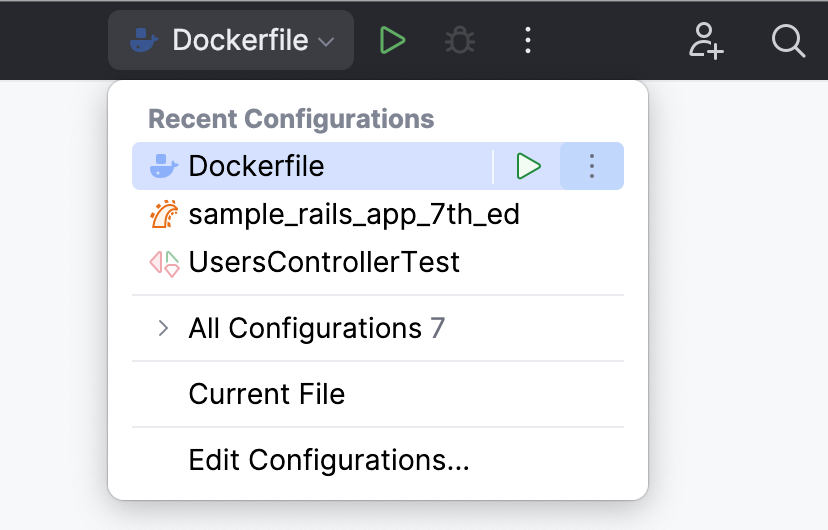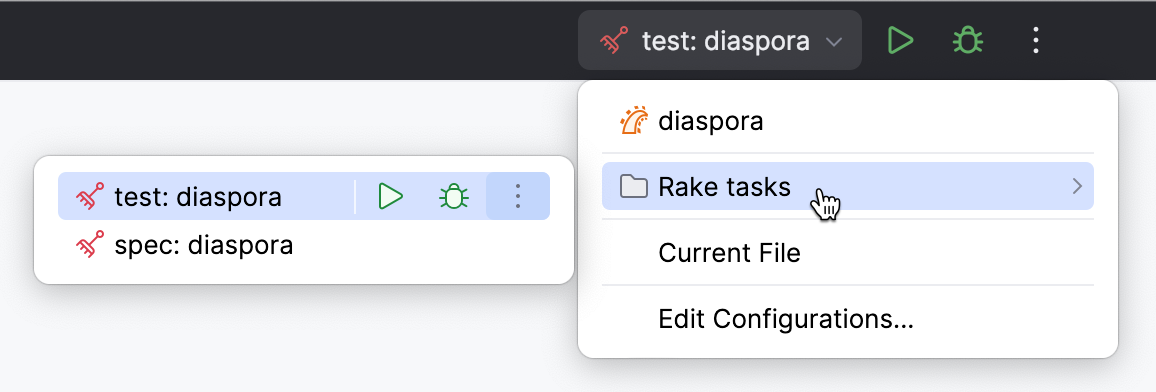Run/debug configurations
Configure: Run | Edit Configurations
RubyMine uses run/debug configurations to run, debug, deploy, and test your code. Each configuration is a named set of startup properties that define what to execute and what parameters and environment should be used.
You can customize configuration parameters according to your requirements, for example:
For the Rails run/debug configuration, you can specify a server type (such as Puma or Passenger), IP address and port, environment (development by default), and so on.
For the Ruby run/debug configuration, you can define command-line arguments, pass the required environment variables, and so on.
For RSpec, you can choose a folder containing the required tests and provide custom runner options.
Let's see on how to work with run/debug configurations in general - from creating a temporary configuration to sharing configurations through VCS.
There are two types of run/debug configurations:
Temporary — created every time you run a Ruby script, Rails server, test, or another command without configuration.
Permanent — created explicitly from a template or by saving a temporary configuration. Permanent configurations remain as part of your project until you remove them.
Whenever you run, debug, or test your code, RubyMine either uses an existing permanent run/debug configuration or creates a new temporary one.
Permanent configurations have opaque icons while the icons of temporary configurations are semi-transparent. The red cross over the configuration icon indicates an error in configuration settings.

The maximum number of temporary configurations is 5. The older ones are automatically deleted when new ones are added. If necessary, you can increase this limit in Settings | Advanced Settings | Run/Debug | Temporary configurations limit.
RubyMine provides the following ways to create a permanent run/debug configuration:
Create from a template or copy an existing configuration.
Select a temporary configuration in the run/debug configuration switcher, click
and select Save Configuration.

Alternatively, select a temporary configuration in the Run/debug configurations dialog and click
on the toolbar.
RubyMine provides run/debug configuration templates for different languages, tools, and frameworks. The list of available templates varies depending on the installed and enabled plugins.
Go to Run | Edit Configurations. Alternatively, press , then .
In the Run/Debug Configurations dialog, click
on the toolbar or press . The list shows the run/debug configuration templates.

For a new run/debug configuration, specify the following settings:

Name: specifies the configuration name.
Allow parallel run: If this option is enabled, you can launch a run configuration multiple times in parallel instead of rerunning it. Each runner will start in its own tab of the Run or Debug tool window.
Store as project file: Enable this option to save your configuration as a project file and share it with team members through VCS.
Configure settings specific for the selected configuration type (for example, Ruby, Rails, or RSpec).
Before Launch: In this area, you can specify tasks that must be performed before running a configuration.
Show this page: Enable this option to show the run/debug configuration settings prior to actually starting it.
Activate tool window: Use this option to specify whether or not the Run/Debug tool window opens when you start the run/debug configuration.
You can either run the configuration right away or save the configuration to run it later.
To save the run configuration for later, click OK.
To run the configuration right away, click Run.
In this area, you can specify tasks to be performed before starting the selected run/debug configuration. The tasks are performed in the order they appear in the list.
Item | Shortcut | Description |
|---|---|---|
Click this icon to add one of the following available tasks:
| ||
Click this icon to remove the selected task from the list. | ||
Click this icon to edit the selected task. Make the necessary changes in the dialog that opens. | ||
Click these icons to move the selected task one line up or down in the list. The tasks are performed in the order that they appear in the list. | ||
Show this page | Select this checkbox to show the run/debug configuration settings prior to actually starting the run/debug configuration. | |
Activate tool window | By default this checkbox is selected and the Run or the Debug tool window opens when you start the run/debug configuration. Otherwise, if the checkbox is cleared, the tool window is hidden. However, when the configuration is running, you can open the corresponding tool window for it yourself by pressing or . |
You might want to share your run/debug configurations so that your teammates could run the application using the same configuration or enable them to remotely attach to the process you are running.
RubyMine provides a mechanism to store your run/debug configurations as project files and share them through VCS. The same mechanism can also be used when you want to send your configuration as a file to someone else, create a local backup of your run/debug configurations, or import them from a file.
Legacy .ipr-based projects do not support individual run/debug configurations. With legacy projects, you can only share all configurations at once by adding the .ipr file to the VCS.
Go to Run | Edit Configurations. Alternatively, press , then .
Select the run/debug configuration you want to share, enable the Store as project file option, and specify the location where the configuration file will be stored.
You can configure any location unless compatibility with RubyMine 2019.3 and earlier is required. For compatibility with these versions, store the file in the suggested location.
(Optional) If the .idea directory is added to VCS ignored files, the .idea/runConfigurations subfolder will be ignored, too. If the project uses Git, you can share .idea/runConfigurations and leave .idea ignored by modifying .gitignore as follows:
/.idea/* !/.idea/runConfigurations
note
Turning on the Store as project file option does not submit anything to the VCS. For run/debug configurations to make their way to a shared repository, you have to check them in like the other versioned files.
All run/debug configurations are based on templates, which implement the startup logic, define the list of parameters and their default values. The list of available templates is predefined in the installation and can only be extended via plugins. However, you can edit default parameter values in each template to facilitate the setup of new run/debug configurations.
Go to Run | Edit Configurations. Alternatively, press , then .
In the left-hand pane of the run/debug configuration dialog, click Edit configuration templates.

In the Run/Debug Configuration Templates dialog that opens, select a configuration type.

Specify the desired default parameters and click OK to save the template.
When there are many run/debug configurations of the same type, you can group them in folders for easier access.

Go to Run | Edit Configurations. Alternatively, press , then .
In the Run/Debug Configurations dialog, select a configuration type and click
on the toolbar. A new empty folder for the selected type is created.
Specify the folder name in the text field to the right or accept the default name.
Select the desired run/debug configurations and move them under the target folder.
Apply the changes. If a folder is empty, it will not be saved.
When you no longer need a folder, you can delete it . The run/debug configurations grouped under this folder will be moved under the root of the corresponding run/debug configuration type.
Most types of run/debug configurations have the Before Launch section where you can specify tasks that must be performed before executing the configuration. For example, you can run the db:prepare Rake task before running a test configuration.
To add a task, expand the Before Launch section, click Add , select the desired task type and specify its parameters if required.
You can execute the following tasks before launching a run/debug configuration:
Launch Web Browser | Opens the specified URL in the selected browser. |
Run External tool | Starts another application configured in External Tools. In the dialog that opens, select one or multiple applications you want to run. |
Run Another Configuration | Starts another run/debug configuration. In contrast to the Compound configuration, this way of running multiple configurations lets you define the order in which the configurations are started. |
Run File Watchers | Applies all currently active file watchers. |
Run Remote External tool | Executes a remote SSH external tool. |
Run Grunt task | Runs a Grunt task. |
Run Gulp task | Runs a Gulp task. |
Run npm script | Executes an npm script. |
Compile TypeScript | Runs the built-in TypeScript compiler and thus makes sure that all the changes you made to your TypeScript code are reflected in the generated JavaScript files. In the TypeScript Compile Settings dialog that opens, select or clear the Check errors checkbox to configure the behaviour of the compiler in case any errors are detected:
|
Generate CoffeeScript Source Maps | Generates the source maps for your CoffeeScript sources. In the dialog that opens, specify where your CoffeeScript source files are located. |
Run Shell Script | Runs a specified shell script. Note that you need to create the Shell Script configuration for this. |
Run Rake task | Adds a Rake task to be executed prior to running or debugging. |
Run JRuby compiler | Executes JRuby compiler with the specified target path, compiler process heap size, and command line parameters (if any). |
Show this page | Select this checkbox to show the run/debug configuration settings prior to actually starting the run/debug configuration. |
Activate tool window | By default this checkbox is selected and the Run or the Debug tool window opens when you start the run/debug configuration. Otherwise, if the checkbox is cleared, the tool window is hidden. However, when the configuration is running, you can open the corresponding tool window yourself by pressing or . |
